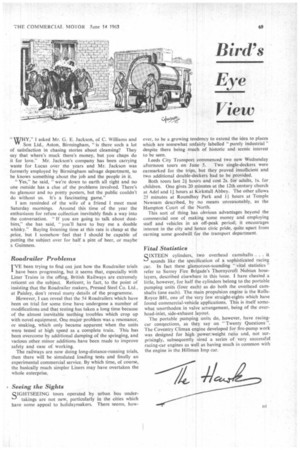Bird' s Eye View
Page 71

If you've noticed an error in this article please click here to report it so we can fix it.
"WHY," I asked Mr. G. E. Jackson, of C. Williams and
" Son Ltd., Aston, Birmingham, "is there such a lot of satisfaction in chasing stories about cleansing? They say that where's muck there's money, but you chaps do it for love." Mr. Jackson's company has been carrying waste for Lucas over the years and Mr. Jackson was formerly employed by Birmingham salvage department, so he knows something about the job and the people in it.
Yes," he said, "we're down to earth all right and no one outside has a clue of the problems involved. There's no glamour and no pretty posters, but the public couldn't do without us. Its a fascinating game."
I am reminded of the wife of a friend I meet most Saturday mornings. Around this time of the year the enthusiasm for refuse collection inevitably finds a way into the conversation. "If you are going to talk about dustbins,she has said, you'll have to buy me a double whisky." Buying listening time at this rate is cheap at the price, but I somehow feel that I should be capable of putting the subject over for half a pint of beer, or maybe a Guinness.
Roadrailer Problems
I'VE been trying to find out just how the Roadrailer trials have been progressing, but it seems that, especially with Liner Trains in the offing, British Railways are extremely reticent on the subject. Reticent, in fact, to the point of insisting that the Roadrailer makers, Pressed Steel Co. Ltd., at Paisley, don't reveal many details of the programme.
However, I can reveal that the 54 18.oadrailers which have been on trial for some time have undergone a number of modifications and that testing has taken a long time because of the almost inevitable teething troubles which crop up with novel equipment. One major problem was a resonance, or snaking, which only became apparent when the units were tested at high speed as a complete train. This has been overcome by additional damping of the springing, and various other minor additions have been made to improve safety and ease of working.
The railways are now doing long-distance-running trials, then there will be simulated loading tests and finally an experimental commercial service. By which time, of course, the basically much simpler Liners may have overtaken the whole enterprise.
Seeing the Sights
q1GHTSEEING tours operated by urban bus under" takings are not new, particularly in the cities which have some appeal to holidaymakers. There seems, how
ever, to be a growing tendency to extend the idea to places which are somewhat unfairly labelled "purely industrial" despite there being much of historic and scenic interest to be seen.
Leeds City Transport commenced two new Wednesday afternoon tours on June 5. Two single-deckers were earmarked for the trips, but they proved insufficient and two additional double-deckers had to be provided.
Both tours last 2+ hours and cost 2s. for adults, Is. for children. One gives 20 minutes-at the 12th century church at Adel and 1+ hours at Kirkstall Abbey. The other allows 25 minutes at Roundhay Park and 14 hours at Temple Newsam described, by no means unreasonably, as the Hampton Court of the North.
This sort of thing has obvious advantages beyond the commercial one of making some money and employing staff and vehicles in an off-peak period; it encourages interest in the city and hence civic pride, quite apart from earning some goodwill for the transport department.
Vital Statistics
SIXTEEN cylinders, two overhead camshafts . . . it. sounds like the specification of a sophisticated racing car. In fact these glamorous-sounding "vital statistics" refer to Surrey Fire Brigade's Thornycroft Nubian hoselayers, described elsewhere in this issue. I have cheated a little, however, for half the cylinders belong to the portable pumping units (four each) as do both the overhead camshafts (one each). The main propulsion engine is the RollsRoyce B81, one of the very few straight-eights which have found commercial-vehicle applications. This is itself somewhat unorthodox in valve arrangement, being of the overhead-inlet, side-exhaust layout.
The portable pumping units do, however, have racingcar conqections, as they say on "Twenty Questions The Coventry Climax engine developed for fire-pump work was designed for high power:weight ratio and, not sur prisingly, subsequently sired a series of very successful racing-car engines as well as having much in common with the engine in the Hillman Imp car.
























































































































































